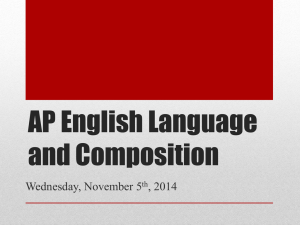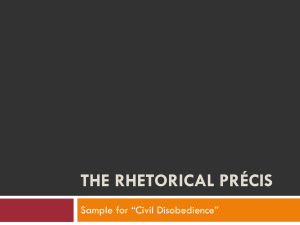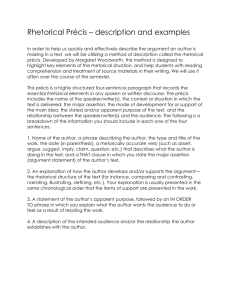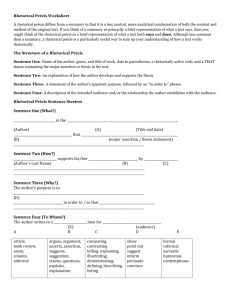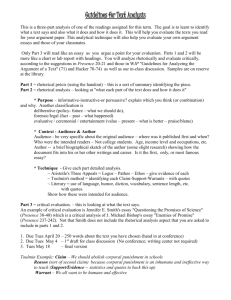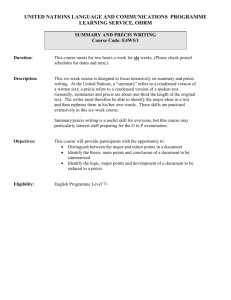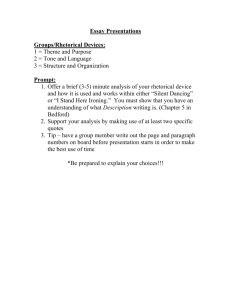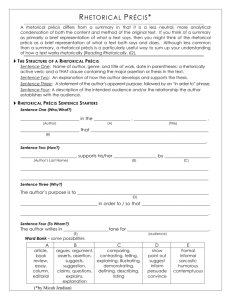American Values Sequence - Granite-Hills-English-ECAP-Wiki
advertisement
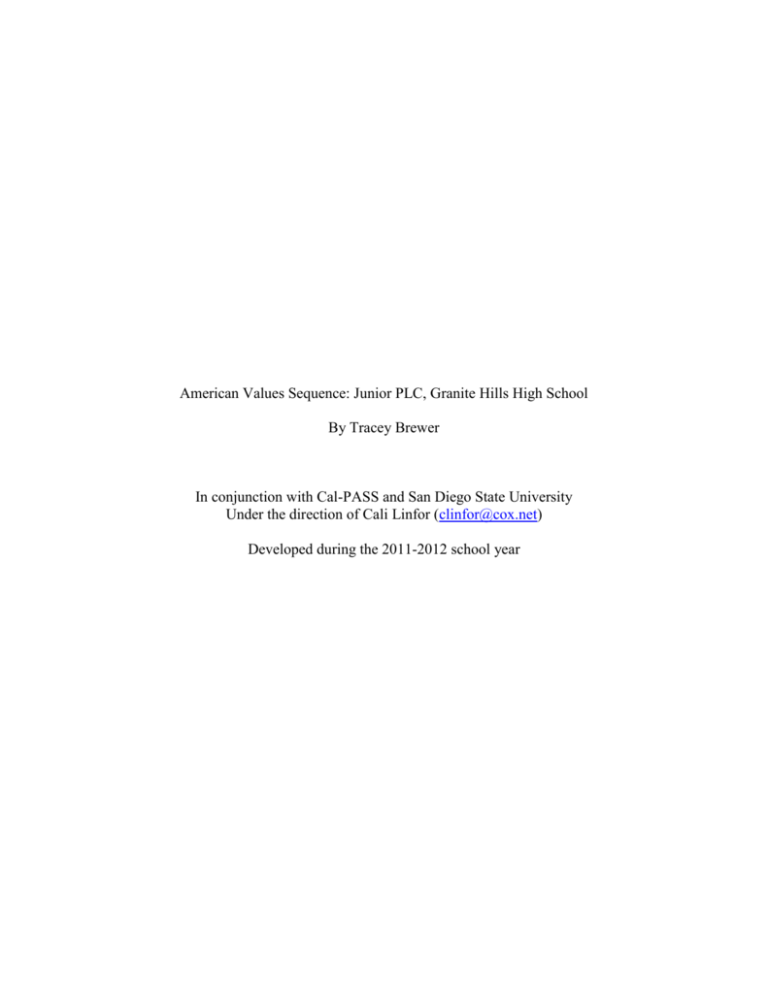
American Values Sequence: Junior PLC, Granite Hills High School By Tracey Brewer In conjunction with Cal-PASS and San Diego State University Under the direction of Cali Linfor (clinfor@cox.net) Developed during the 2011-2012 school year West Hills High School Cal-PASS Curriculum Alignment Project “The World House” Dr. Martin Luther King Jr. Assignment Type 1: Analyzing a Non-Fiction Text TEACHER VERSION READING RHETORICALLY The Reading Process Optional: Language Arts Standard: Writing Applications 2.3 Write brief Reflective Composition on topic related to text, exploring the significance of personal experiences, events, conditions, or concerns by using rhetorical strategies (e.g., narration, description, exposition, persuasion.) Prereading Reading Postreading Pre Reading Activities NOTE: These articles are to be read in sequence by the class, probably about two articles per week. Some activities are repeated across multiple articles because students need additional practice, but the additional practice often is more and more independent, rather than scaffolded in class. Getting Ready to Read Pre-reading Activity: In class brainstorm: What traits do Americans value in themselves? What traits might a foreigner identify as major American traits? (How are Americans perceived by foreigners?) Pre Reading Activity: Students create a class definition of stereotypes, and list some examples of commonly-held stereotypes. Pre Reading Activity: LOTS of vocab checking in this stage. I emphasize the reasons for this after the first article—(1) one cannot understand a text if one is missing out on some of the key terms, and (2) knowing what the vocabulary means can help readers determine who the target audience is. (“BMPS”): Students skim through the article, “Black Men and Public Space” by Brent Staples. Highlight or underline all of the vocabulary words with which they are unfamiliar. Divide class into groups—each group finds definitions for unfamiliar vocab in a given paragraph and shares out with class. (“HD”): Students skim through the article, “The Handicap of Definition” by William Raspberry. Vocab research activity is repeated as with “BMPS”. (“CTC”): Students discuss subtitle of article, “Crippled by their Culture” by Thomas Sowell (it refers to “black rednecks”). What might the author mean by this term? What’s a redneck? (“iWorld”): Students skim the article, “Society is dead, we have retreated into the iWorld” by Andrew Sullivan. The do the vocab check again. (“GWUH”): Students skim the article, “Guest Workers and the U.S. Heritage” by Jay Bookman. They do the vocab check again. Review persuasive appeals with the class. Language Arts Standard: Reading Comprehension 2.1 Analyze the features and rhetorical devices of texts and the way in which authors use those features and devices. Surveying the Text (“BMPS”): Before reading the essay, review the difference between claim and evidence. You will be marking major claims as you read. (“CTC” and “iWorld” and “GWUH”): Point out how certain vocabulary is actually a type of allusion (review definition of allusions). Students should notice how Thomas Sowell (“CTC”) and Jay Bookman (“GWUH”) use historical allusions, and Andrew Sullivan (“iWorld”) uses pop culture and mythological allusions. Making Predictions (“BMPS”): After reading the first paragraph from the essay, predict the point of the essay. What is the author implying about himself? Check your prediction after reading the second paragraph. (“HD”): After reading the first paragraph, discuss as a class how black people are “defined” in our culture. Discuss stereotypes of black people in America. (“iWorld”): Predict the target topic of this article, based on the title. Why might the author believe that modern technology (iPods) has destroyed society? (“GWUH”): Look at the diction in the title of this essay. What does the author’s usage of “guest workers” imply about his point of view? (Consider what other terms are used to describe workers from other countries.) Language Arts Standard: Word Analysis and Systematic Vocabulary Development 1.0 (as well as 1.1 and 1.2) Students apply their knowledge of word origins to determine the meaning of new words encountered in reading materials and use those words accurately. Introducing Vocabulary (“BMPS”): Students have already identified and defined difficult vocabulary prior to reading. This vocab includes terms like: Affluent Uninflammatory Foyer Elicit Perpetrators Retrospect Intimidation Bravado Perilous Same process for other articles, except “CTC”, as it has fewer vocab terms and can be dealt with while reading. Reading Looking Closely at Language Language Arts Standard: Reading Comprehension 2.1 Analyze both the features and the rhetorical devices of texts and the way in which authors use those features and First Reading DIRECTIONS: Read the essays as your teacher assigns them. As you read, think about the predictions you made. Rereading the Text (“BMPS”): Have students reread the article and annotate as they read. They should mark major claims made by the author and write their own devices. reactions to the author’s content in the margins. Now, have students in pairs compare their annotations. (“CTC” and “iWorld” and “GWUH”): Label all the allusions in the texts. Also label hyperbole in “iWorld”. Use the authors’ allusion device to figure out the audience of the texts. Explain why the allusions will be effective with a specific audience. (“CTC”): Have students read essay three paragraphs at a time, pausing to summarize (label) what the author is doing in each chunk. Ask students to identify the point in the essay where the author shifts from disproving theories about black performance, to proving his own theory. (“GWUH”): Have students mark examples of logos and pathos in the essay. Rereading the Text Activity—Rhetorical Précis/Response (“BMPS”): Teach rhetorical précis to the class. Create a précis as a class, to be included in student notebooks for future reference. (“HD”): Have students write a précis as homework. Use the Epson projector on the day they submit their work to check their success. Give credit for attempting the précis, but do not grade it. (“CTC”): Have students write a précis as homework. Grade this one. Précis Example: In his essay, “Black Men and Public Space” (1986), Brent Staples, a writer for Harper’s Magazine, explains that black men walking at night are perceived as intimidating by women who walk near them, but this problem can be solved by such things as the black man whistling to appear less threatening. In the beginning of the essay, he presents chronological stories about being feared by others, and he concludes with his current solution to those past encounters. Staples writes this essay in order to prove to his audience that appearances are deceiving. His audience appears to be college-educated people who are not black men, since he assumes black men are already aware of this problem. Language Arts Standard: Reading Comprehension 2.2 Analyzing the Idea Structure (“BMPS”): This is done via class discussion while creating the class sample précis. Analyze the way in which clarity of meaning is affected by the patterns of organization, hierarchical structures, repetition of main ideas, syntax, and word choice in the text. Language Arts Standard: Word Analysis and Systematic Vocabulary Development 1.0 (as well as 1.1 and 1.2) (“HD” and “CTC”): Done through student précis. (“GWUH”): Done through class discussion. Focus on places where author switches persuasive techniques. Revisiting Vocabulary: Critical Vocabulary Work (“BMPS”): Students discuss how vocabulary reveals the author’s target audience. Other articles: Same. Students apply their knowledge of word origins to determine the meaning of new words encountered in reading materials and use those words accurately. Post-reading Activities Language Arts Standard: Reading Comprehension 2.4 Make warranted and reasonable assertions about the author’s arguments by using elements of the text to defend and clarify interpretations. Language Arts Standard: Reading Comprehension 2.5 Analyze an author’s implicit and explicit philosophical assumptions and beliefs about a subject. Language Arts Thinking Critically After reading “BMPS”, “HD”, and “CTC”, lead students in a fullperiod debate about the way black people are stereotyped in American society. Ask students to evaluate the primary claims made by these authors. How accurate are these claims? What counter-arguments do they have? After reading “GWUH”, have students discuss the author’s primary argument—point out the bullet-point part of the article, which many will ignore, and the reference to Bush’s proposal, which will suggest the purpose of the article. Have students discuss how well the author’s use of different persuasive appeals will accomplish his purpose. Standard: Reading Comprehension 2.6 Critique the power, validity, and truthfulness of arguments set forth in public documents; their appeal to both friendly and hostile audiences; and the extent to which the arguments anticipate and address reader concerns and counterclaims (e.g., appeal to reason, to authority, to pathos and emotion.) These questions are designed to develop the kinds of close reading skills assessed by the Reading Skills sections of the EPT. Students should be able to: Identify important ideas Understand direct statements Draw inferences and conclusions Detect underlying assumptions Recognize word meanings in context Respond to tone and connotation Writing Rhetorically Connecting Reading to Writing Language Arts Standard: Reading Comprehension 2.2 Analyze the way in which clarity of meaning is affected by the patterns of organization, hierarchical structures, repetition of the main ideas, syntax, and word choice in the text. Writing Strategies 1 1 Demonstrate an understanding of the elements of discourse (e.g., purpose, speaker, audience, form) when completing narrative, expository, persuasive, or descriptive writing assignments Have students read the introduction to “The Values Americans Live By” by L. Robert Kohls. Discuss author’s purpose, audience, major claim, as revealed by the introduction. Divide students into groups. Each group is assigned one of the 13 sub-claims from the article (the 13 values) to (1) summarize, and (2) think of an example that supports the claim from their prior knowledge—example can be hypothetical, too, and (3) present (1) and (2) to the class. Writing Prompt: Evaluate the accuracy of two of the claims made by Kohls using evidence from (1) at least one of the other articles studied during this unit, (2) your knowledge of current and historical events, and (3) your own personal experience. Should this article be used as an educational tool by recent immigrants to the U.S.? The Writing Process Language Arts Standard: Writing Strategies 1.1 Demonstrate understanding of the elements of discourse (e.g., purpose, speaker, audience, form) when completing narrative, expository, persuasive, informational, or descriptive writing assignments Prewriting Writing Revising Editing See the Attached Prompt. In Handouts
